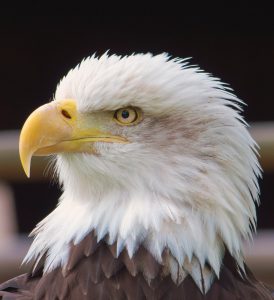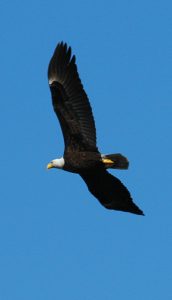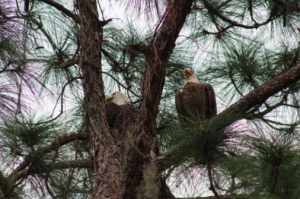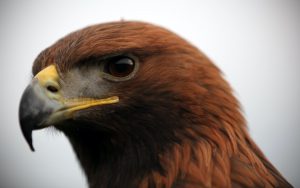While it’s easy to get enraptured by the world of raptors, as the emblem of our nation, eagles distinguish themselves as some of our most enchanting birds of prey. They’re apex predators and great indicators of environmental health tipping us off to imbalances and pollution in our ecosystems.
Read on to learn more about what makes an eagle an eagle and a brief overview of Florida’s two eagle species: the bald eagle and the golden eagle. For more on eagles’ natural history, conservation efforts, and more, watch our Wild Sarasota webinar: Eagles of Florida.
Everything about Eagles
So, what makes an eagle an eagle?

An eagle is generally defined as a raptor, or bird of prey, stronger than a Buteo (hawk). This includes all of the 60 species found in the family Accipitridae classified into groups like fish/sea eagles, snake/serpent eagles, booted/true eagles, and Harpy/giant forest eagles.
While that definition may be helpful to ornithologists (bird specialists), it can be a bit confusing. Fortunately, there are other key characteristics that help define eagles. All eagles have a fully feathered head and incredible vision with eyes angled out at 30° and the ability to perceive 5 basic colors. Eagles subsist largely on live prey. As monogamous pairs, eagles often reuse their nests year to year. Young eaglets tend to mature slowly, taking up to 5 years to be able to reproduce and then often having only 1-2 eaglets survive to fledge from the nest. Immature eagles are mostly solid brown, attaining their adult plumage of feathered white heads and tails for which they are named when they reach maturity.
Bald Eagles (Haliaeetus leucocephalus)

Derived from the world “piebald” meaning “white marked” bald eagles have chocolate bodies with white heads and tails. Bald eagles have an impressive stature with an 8 foot average wingspan for females and 6 foot average for males.
Bald eagles are a type of sea eagle meaning they subsist mainly off of fish, but they may also consume reptiles, small mammals and crustaceans. They occasionally hunt cooperatively and tend to follow a gorge then fast routine where they can go without food for upwards of a week.
Bald eagles build impressive nests that are near the largest of all birds. In fact, the biggest nest was found in St. Petersburg, Florida and measured 2.9m x 6.1m or 9.5ft x 20ft.

Named the national emblem of the United States in 1782, the bald eagle was a well established species with an estimated 100,000 nesting pairs. Since then, they have had a troubled history in this country as hunting, habitat loss, and pesticide use brought populations down to just 487 pairs in 1963. Fortunately, due to the work of activists, conservationists, and with the ban of DDT, the bald eagle was removed from the endangered species list in 2007.
Golden Eagles (Aquila chrysaetos)

Less commonly found in Florida as their population is concentrated out west, the golden eagle is a nimble raptor with astonishing maneuverability. They have dark brown plumage with a golden sheen on the back of their head and their legs are feathered all the way to their toes. In flight, their tail feathers project further than does their head.
Smaller than the bald eagle, the golden eagle is about 30 inches long with a 6-7 foot wingspan. Their position as a formidable predator means that golden eagles are the most common official national animal around the world.
Learn More
Join us for an eagle walk at some of the Sarasota County Preserves. Check the Sarasota County Parks, Recreation, and Natural Resources Event Guide and at UF/IFAS Extension Sarasota County EventBrite registration.
Read all our Wild Sarasota blogs HERE
Excited by eagles? To learn more, watch our Wild Sarasota webinar: Eagles of Florida and truly engross yourself in the world of eagles.
 0
0
